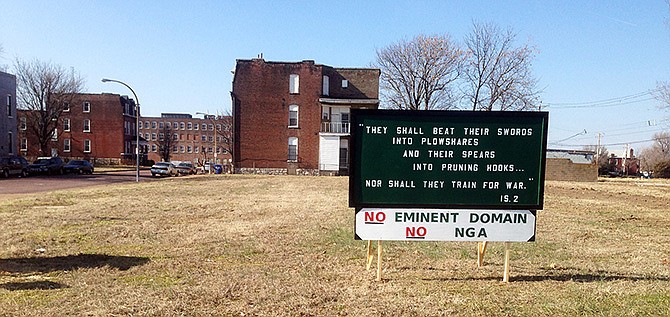ST. LOUIS (AP) - The departure of the Rams to Southern California killed a plan to build a $1 billion riverfront stadium to keep the team in St. Louis, making city officials more anxious than ever to keep the federal government from moving a spy agency's regional headquarters to nearby southern Illinois.
City leaders envisioned a new Rams stadium along the Mississippi River and the proposed $1.6 billion National Geospatial-Intelligence Agency complex as economic engines for St. Louis' impoverished north side. But the NFL's approval of the Rams' plan to return to Los Angeles has pinned the city's hopes solely on the spy agency complex decision, which could come as soon as March.
"It's even more important now, especially since we don't have that stadium project," said Missy Kelley, president and CEO of the nonprofit Downtown STL Inc., which promotes economic development in the city's core.
St. Louis is competing with St. Clair County in Illinois, which is just across the Mississippi River and which has offered nearly 400 acres of donated land near Scott Air Force Base to the defense and intelligence agency, a combat support branch of the Department of Defense.
At stake are more than 3,000 high-tech agency jobs with average salaries of more than $80,000, along with thousands of short-term construction jobs and a likely influx of ancillary businesses such as private defense contractors, restaurants and gas stations.
St. Louis also stands to lose more than $2 million per year in earnings taxes paid by anyone who works in the city, regardless of where they live. The NGA's western regional headquarters are currently located near the Anheuser-Busch brewery south of downtown, but the agency says it needs more space and more modern facilities.
Mayor Francis Slay has said "losing the NGA would be a devastating blow to our city's economy." Other project supporters, including some members of the St. Louis Metropolitan Clergy Coalition, have suggested the federal government has an obligation - if not a moral imperative - to choose St. Louis. Among other points, they cite the Department of Housing and Urban Development's designation last year of St. Louis as a preferred recipient for federal anti-poverty assistance.
Their arguments don't wash with Madison County board Chairman Alan Dunstan, who supports the efforts of adjacent St. Clair County and thinks it's clearly the better site.
"Sooner or later, the issue is what's best for NGA," he said. "If this was a business looking at these two sites, this decision would already be made. And it would go to St. Clair County."
Rams owner Stan Kroenke cited St. Louis' economic woes in his report to fellow owners about why they should grant him permission to move the team. By one measure, its economic growth is near the bottom of more than 500 U.S. cities. A city whose population appeared on track to reach 1 million in the 1950s now has slightly more than 300,000 residents. And St. Louis has one of the nation's highest homicide rates.
Some NGA employees have expressed fears for their safety if the agency moves to north St. Louis, federal records show. The specter of violent crime has also been raised by boosters of the Illinois effort.
While most of the 100-acre St. Louis site consists of vacant lots and crumbling buildings, city elected leaders have approved the use of eminent domain to legally force out any of the fewer than 50 homeowners who may resist selling their property to the government. The city expects to spend about $10 million to buy up the needed residential properties and about $45 million to relocate businesses - money it would expect to recoup in the NGA sale.

